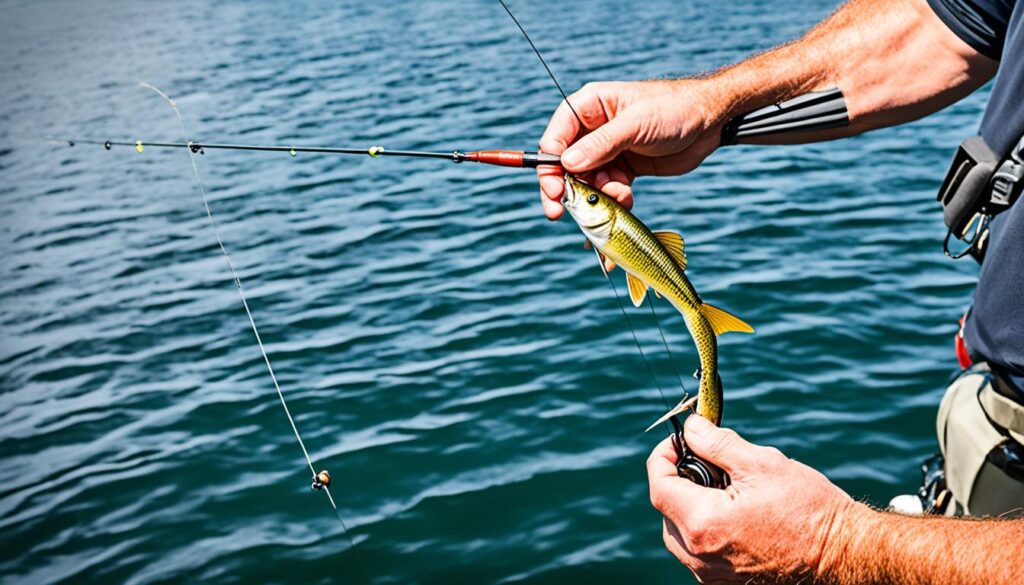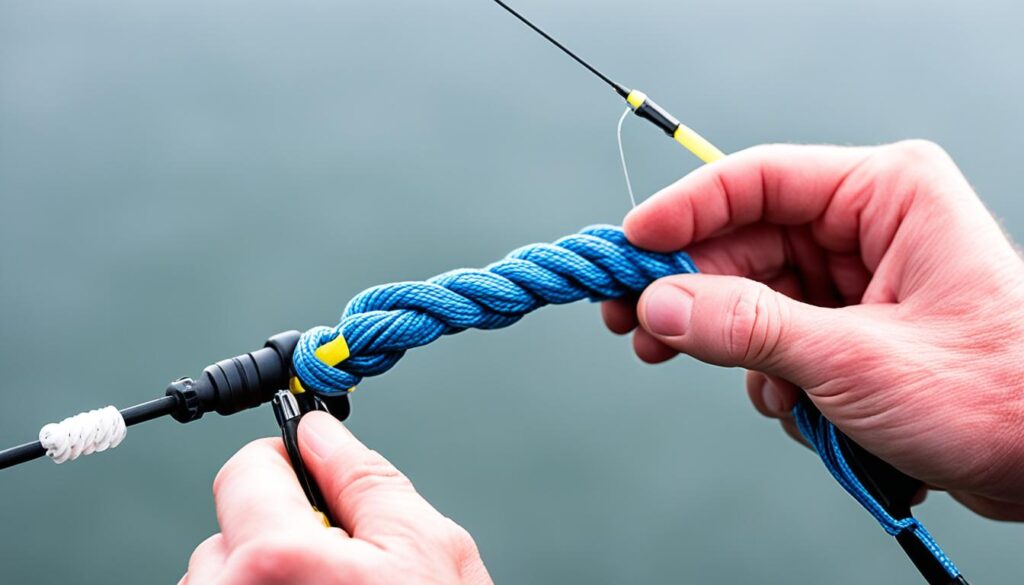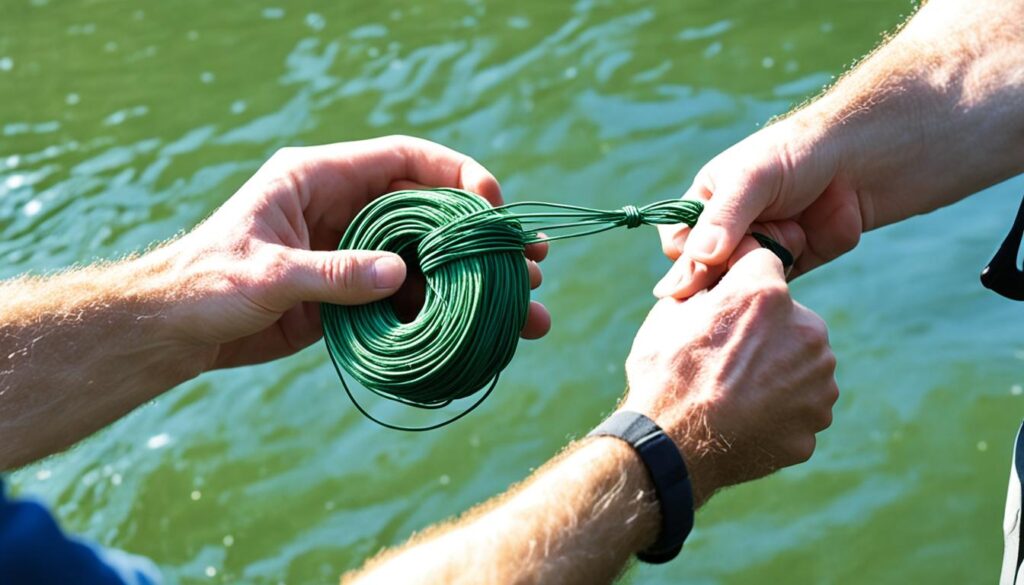Ready to step up your knot-tying game? Learn how to Tie a uni knot is a top pick for all levels of fishermen. It works in the sea and freshwater, making it a must-have skill for anyone with a fishing rod.
Tying a uni knot is simpler than you might guess. Just do as follows:
- String the line through the hook’s eye and line it up with the main line.
- Make a loop with the tag end and wrap it around the line.
- Wrap the tag end around at least five times.
- Wet the knot and pull it tight.
Step-by-step Uni Knot Instructions
Here’s how to tie the uni knot in a few simple steps:
Start by passing the line through the hook’s eye. Then, align it with the main line.
Now, make a loop with the tag end. Wrap this loop around the doubled line.
Do at least five wraps around the doubled line with the tag end.
Lastly, make the knot wet and pull it tight to secure your fishing line.
The uni knot is excellent for many fishing needs. It’s both versatile and strong.
“The uni knot is not only easy to tie, but it’s also incredibly reliable. It has become my go-to fishing knot for almost all my fishing needs.” – Mark Thompson, experienced angler
Variations of the Uni Knot
The uni knot is great for its adaptability and strength. Different situations call for specific knots in fishing. Today, we’ll look at two versions: the double-line and braid uni knot.
Double Line Uni Knot
This knot works best when you need a robust and full knot on lures or hooks. It involves folding the line and tying a uni knot with this doubled line. This makes a sturdy link and can support heavier fish or tough fishing challenges. Remember, it might take more effort to tie this knot perfectly with many lines. So, take your time and practice when you get it right.
Braid Uni Knot
The braid uni knot is tweaked for braided lines to swivel connections. Braided lines are slippery and need a special knot to grip them. The braid uni knot creates a secure join, stopping the braid from slipping when you catch a big one. Anglers who use braided lines find this knot very helpful.
Looking into these uni knot variations can level up your fishing game. Each one suits different needs, whether the double line for more power or the braid version for braided lines. Knowing these knots better will make you a more adaptable angler.
| Variation | Best Used for | Strength | Complexity |
|---|---|---|---|
| Double Line Uni Knot | Tying knots to lures or hooks | High | Moderate |
| Braid Uni Knot | Braid to swivel connections | High | Low |
Benefits of the Uni Knot for Fishing
The uni knot is excellent for all kinds of fishing. It’s perfect for both new and skilled anglers. The uni knot can make your fishing better in many ways. Here’s why you should use it:
- Easy to learn and tie: Mastering the uni knot is a breeze for anyone. Its simple steps make it great for anglers at any level.
- Versatility: You can use the uni knot in many fishing settings. It works well with various lines, hooks, and lures. From catching crappie to landing catfish, it’s up to the challenge.
- Clean and narrow knot: A well-tied uni knot stays slim and clean. It won’t pick up moss or grass easily, keeping your line neat and reducing tangles and snags.
- Incredible strength: Don’t let its ease fool you; the uni knot is strong. It’s perfect for tackling big fish with light lines without breaking.
Aaron Martens, a famous angler, swears by the uni knot. It’s often his top choice for fishing. Many anglers trust it for both freshwater and saltwater fishing. With the uni knot, feel sure and steady on the water.

The Braid Uni Knot for Braid to Swivel Connections
The Braid Uni Knot is a twist on the uni knot, perfect for braid lines and swivels. It’s super strong and easy to tie, and it’s praised by all types of anglers.
Here’s how to do the Braid Uni Knot:
- Start by threading the braid through the swivel or hook’s eye.
- Put the tag end through the eye once more.
- Create a loop around the mainline with the tag end.
- Wrap the tag end around 10-12 times through the loop.
- Now, pull the mainline and tag end tight, tightening the knot towards the eye.
- Lastly, snip off the tag end.
The Braid Uni Knot creates a tight link between your braid and swivels. It holds firm against heavy fish and vital water. This knot is excellent for those fishing in fresh and saltwater, offering a trustworthy connection.

Trust your fishing gear with the Braid Uni Knot and enjoy the sport. Many anglers prefer it because of its strength and stability. Learn and use this knot to improve your fishing adventures!
Advantages of the Uni Knot for Marrying Lines Together
The uni knot is excellent for joining fishing lines. It’s simple and reliable, which makes it one of the best knots. It’s not like other knots that are hard to tie. You can learn and use it quickly, even when it’s tough. Anglers love it because they can trust it when they need to.
Its small size is also a plus. Unlike bigger knots, the uni knot won’t hurt your gear when you cast. This means fishing stays smooth and easy with the uni knot.
The uni knot shines when you need to connect different lines. For example, when you put a braid with mono or fluorocarbon leader. It stays strong under the pressure of large fish. This gives fishermen confidence when they’re after their big catch. No matter the fish, the uni knot keeps your lines together, making fishing better.
Its easy tying and versatility make the uni knot a top pick for all anglers. Whether you just started or are an expert, this knot is simple and trustworthy. It helps improve your fishing game.
| Advantages of the Uni Knot for Marrying Lines Together |
|---|
| Easy to learn and tie |
| Small size, doesn’t damage guides |
| Secure connection for joining different lines |
| Versatile and suitable for anglers of all skill levels |
The Uni Knot for Tying Hooks and Lures to Line
The uni knot is great for attaching hooks and lures to fishing lines. It’s better than other knots with light or braided lines. It keeps the line from slipping when you catch a fish.
Twisting the line 10 to 12 times makes it strong for braided lines. It’s easy to tie and works well for any hook or lure size. The uni knot keeps your bait secure.
“The uni knot is my go-to knot for tying hooks and lures. It’s strong, reliable, and easy to tie. I’ve used it for years and it hasn’t let me down.” – John Smith, Professional Angler
Step-by-Step Guide to Tying a Uni Knot for Hooks and Lures
To tie a uni knot, follow these steps:
- Pass the line through the hook or lure’s eye and leave a tag end.
- Make a loop with the tag end next to the main line.
- Wrap the tag end around both lines at least 5 times.
- Wet the line and pull both the tag end and main line to tighten.
- Snip off the extra tag end to finish.
The uni knot is easy for anyone to learn. With practice, tying it will become second nature. This knot works for many fishing lines, such as mono, fluoro, and braid.
Comparison of the Uni Knot with Other Fishing Knots
| Knot | Strength | Versatility | Simplicity |
|---|---|---|---|
| Uni Knot | High | Very versatile | Easy to tie |
| Clinch Knot | Medium | Limited to monofilament lines | Relatively simple |
| Improved Clinch Knot | Medium-High | Works well with monofilament lines | Slightly more complex |
The uni knot beats other knots in strength, versatility, and ease of use. It’s suitable for all fishing lines and keeps your gear secure.
Conclusion
The uni knot is considered one of the top fishing knots. It is known for being simple, strong, and versatile. This knot is great for both new and skilled anglers. It’s easy to learn and helps you fish confidently for various types.
This knot works well with different kinds of fishing lines. Whether you use monofilament, fluorocarbon, or braided line, the uni knot ties them together securely. You won’t worry about your line slipping or snapping while catching a fish. It’s an excellent choice for connecting lines or adding hooks and lures.
Learning the uni knot will improve your fishing adventures and give you the courage to face any fishing task. This knot is simple and strong, making it a favorite for all anglers. So, whether you’re fishing in saltwater or freshwater, you can trust the uni knot as a top fishing knot.
FAQ
How do I tie a uni knot?
To tie a uni knot, start by passing the line through the hook’s eye. Then, form a loop with the tag end. Wrap this loop around the main line five times. Finish by pulling the line tight and wetting it. This secures the knot.
What are the variations of the uni knot?
There are several types of the uni knot. One kind is for using with two lines at once, the double line uni knot. Another is the braid uni knot for connecting braid to swivels. Each variation is suited for different fishing needs.
What are the benefits of using the uni knot for fishing?
The uni knot is loved by many anglers for good reasons. It’s easy to learn and use. It’s strong and creates a neat knot. Pros, like Aaron Martens, trust this knot for its secure hold when fishing.
How do I tie a braid uni knot for braid to swivel connections?
To tie a braid uni knot, first, thread the line through the swivel eye. Next, pass the tag end through the eye again. Then, create a loop with the tag end and wrap it through 10 to 12 times. Finally, pull both lines to tighten the knot. Cut the tag end to finish.
What are the advantages of using the uni knot for marrying lines together?
The uni knot offers simple and reliable line joining. It’s easy to tie even in tough places. This knot doesn’t harm equipment when casting. It’s also strong enough for large fish fights.
Can I use the uni knot for tying hooks and lures to my fishing line?
Absolutely, the uni knot is great for attaching hooks and lures. It grips well even with thin or braided lines. Many anglers prefer it for its ease and dependability.
Why is the uni knot considered one of the best fishing knots?
The uni knot stands out for being simple, adaptable, and robust. It’s easy for new anglers to learn and fits many fishing situations. Its strength across various lines makes it a favorite choice.
